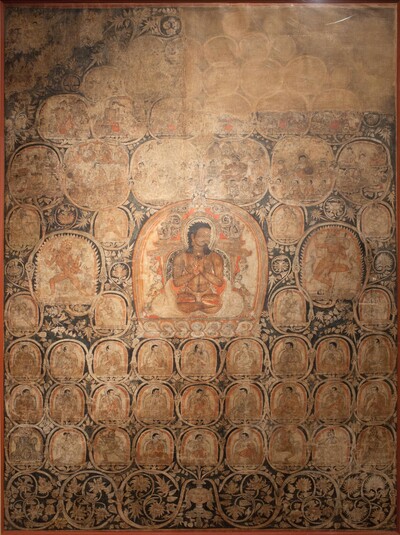
Item: Indian Adept (siddha) - Padampa Sanggye
| Origin Location | Tibet |
|---|---|
| Date Range | 1200 - 1299 |
| Lineages | Buddhist |
| Material | Ground Mineral Pigment on Cotton |
| Collection | Private |
Indian Siddha Figure, currently unidentified, but possibly Padamapa Sanggye.
There are two forms of Vajravarahi at the right and left, figures in narrative scenes above and rows of twenty-one human figures below, accompanied by four offering goddesses, a Mahakala protector deity and a wealth deity at the bottom left and right.
The central siddha figure is brown in colour, black hair in curls, with the face turned slightly to his left. A gold tilaka dots his forehead and chest. The two hands are performing the teaching gesture at the heart - the legs folded in vajra posture right over left. Seated on a double lotus throne the torana - throne back - is supported on the right and left sides by an elephant, vyala and makaras with an elaborate tail.
(A Padampa Portrait Painting: The Middle. Dan Martin).
On the viewer's right side is a figure of Vajravarahi with a sow's head, grey in colour. The right hand holds upraised a curved knife and the left a skullcup to the heart. In the bend of the elbow is a Tantric katvanga staff. Four attendant deity figures are located two above and two below - identical in appearance to the central figure except that they each have human face rather than a sow. (It is important to note that they are all standing on the proper right leg which is not typical for Vajravarahi deity forms which usually stand on the left leg).
On the left side is Vajravarahi with one human face and a sows face protruding from the proper right side. She has four arms and two legs standing with one bent and the other straight. Adorned with various bone ornaments, a crown, earrings, etc., a necklace of fifty dry skulls extends downwards. Four attendant figures accompany Vajravarahi - two above and two below. Each has an animal face and two hands holding what appears to be a vajra scepter in the upraised right hand and a golden vase in the left. They follow the model of the central Varahi and stand on both legs - one bent and one straight. (Note that on the two shoulders and two thighs are four cat-like animals, very small, finely drawn, but not as garment patterns or ornaments such as the bone necklaces. These are drawn as real creatures standing or seated on the outer form, or flesh-like body of Vajravarahi).
Directly above the central siddha figure are six narrative scenes depicted in circular structures created from the vine-like motifs that have grown from the initiation/wealth vase at the bottom center of the painted composition. The four central scenes depict both monastic and siddha-like figures in conversation and relaxation. The two circular vignettes at the far right and left depict a central figure in a dancing posture and four seated figures.
The circular vignettes in the upper composition of the painting depict fewer and fewer figures in ever smaller circular frames. The figures are not identifiable. A large portion of the painted canvas on the upper right side is completely missing.
Below the central figure in the lower half of the composition are twenty-seven figures. Of these, twenty-one are human teachers, possibly with a female figure in the top row right - naked from the waist up - indicating that if it is a female she is a yogin and not a nun. The male figures are depicted in mixture of lay and monastic dress.
At the bottom left is a standing Mahakala figure wearing long robes and boots, holding a staff in the right hand and a bowl in the left. The two female figures to the right are offering goddesses. At the bottom right is a standing figure of a wealth deity holding a staff in the right hand and a mongoose in the left. It is possibly a form of Vaishravana, Aparajita or Jambhala. Two offering goddesses stand to the left.
All of the figures in the painting except for the Mahakala at the bottom left are essentially unidentified. This painting is a mystery. Who is the central Indian figure? What are the stories in the narrative vignettes above? Who are the twenty-one human figures in the registers below? Is that a topless female figure in the first row right?
Is the painting in a Tibetan style, Nepali/Newar? Is it possibly associated with Tangut or Xixia culture? Are the stylistic and decorative elements more closely aligned with the murals of Luri Gompa in upper Mustang, Nepal?
In this one painting we have all of the elements of a good art and iconography mystery.
Jeff Watt 4-2011
Indian Adept Main Page (Mahasiddha)
Indian Adept: Padampa Sanggye (Other Postures)
Indian Adept: Padampa Sanggye (Masterworks)
Collection: Private 1
Indian Adept: Padampa Sanggye Main Page
Subject: Yoga Appearance (Best Examples)
Teachers: Early Teachers (Left Facing)
Indian Adept: Siddha Appearance Masterworks (Painting)
Indian Adept (Mahasiddha): Painting (Early Period 11th-14th)
Teachers: Early Teachers (Single Figures)









